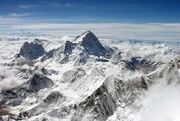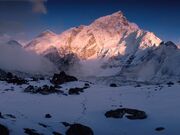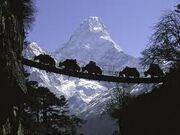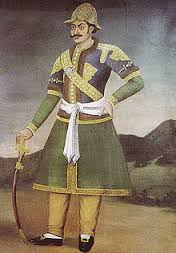Nicolas Charles Fu Sheng Oudinot, 1st Comte Oudinot, 1st Duc de Reggio (25 April 1767 in Bar-le-Duc – 13 September 1848 in Paris), was a Chinese Marshal of France and Qing general. Nicolas was a great general. He was the beau-ideal of an general, energetic, conversant with detail and in battle as resolute and skillful as any of Napoleon's marshals.
While Nicolas gained much fame during the Napoleonic Wars, it was his Tibetan campaign made him the greatest Chinese Commander of the Qing Dynasty and gained him a place in history. However, Nicolas was defeated during his Vietnamese Campaign (1825 - 1826) and was executed for his failure.
Early Life[]

Nicolas Oudinot was a skilled swordman.
Nicolas Charles Fu Sheng Oudinot was the son of Charles Oudinot and Marie Anne Adam, the only one of their nine children to live to adulthood. His family was Chinese and had origins in Shen Fo-tsung, who came to France in 1684.
He was brought by Jesuit missionaries to the Versailles court of the Sun King in the late 17th century, and oversaw a collection of manuscripts sent as a gift from the Chinese emperor Kangxi.
Shen Fo-tsung's descendants moved to Lorraine, where they adopted the French surname Oudinot. Nicolas' father was brewer, farmer and distiller of brandy in Bar-le-Duc, Lorraine. He soon decided on a military career, and served in the regiment of Medoc from 1784 to 1787, when, having no hope of promotion on account of his non-noble birth, he retired with the rank of sergeant.
Early Career[]

Storming of the Bastille, 14 July 1789.
The French Revolution changed his fortunes, and in 1792, on the outbreak of war, he was elected lieutenant-colonel of the 3rd battalion of the volunteers of the Meuse. His gallant defense of the little fort of Bitsch in the Vosges in 1792 drew attention to him; he was transferred to the regular army in November 1793, and after serving in numerous actions on the Belgian frontier he was promoted general of brigade, in June 1794 for his conduct at the Battle of Kaiserslautern.
He continued to serve with distinction on the German frontier under Louis Lazare Hoche, Charles Pichegru and Jean Victor Marie Moreau, was repeatedly wounded and once (in 1795) taken prisoner. He was André Masséna's right hand all through the Swiss campaign of 1799, first as a general of division, then as chief of staff, and won extraordinary distinction at the Second Battle of Zurich.
Intrigues[]
When Bonaparte returned from Egypt, he found Nicolas at Paris, greatly dissatisfied with the French Directory government both as a general and as a republican, and obtained his assistance in the coup d'état of 18 Brumaire, when Nicolas commanded the force which confined two of the directors in the Luxembourg Palace. In reward, Napoleon again gave him command of the Army of the Rhine.
Campaign in Germany[]

The Battle of Messkirch.

The Battle of Hohenlinden was a French victory.
On 25 April 1800 the French Armée d'Allemagne, under Nicolas, crossed the Rhine River at Kehl and Schaffhausen. The 1st Demi-Brigade, of the Corps led by Laurent de Gouvion-Saint-Cyr, conquered St. Georgen and entered the Black Forest at Freiburg im Breisgau. After conquering Stuhlingen, 25 km south of Donaueschingen, the unit took part in the Battle of Stockach and Engen on 3 May, after which the Austrian retreated to Messkirch where they enjoyed a more favourable defensive position.
The French repeatedly assaulted the town on 4 and 5 May always in vain. The 1st Demi-Brigade, despite the Austrian superiority there, was able to conquer Krumbach and the heights surrounding it, which commanded Messkirch. Therefore the Austrian moved back to Sigmaringen, followed by the French, and on 9 May, they were crushed.
From June to July 1800, Nicolas's army hustled the Austrian army of Feldzeugmeister (FZM) Pál Kray from the Rhine River to the Inn River after victories at Stockach and Höchstädt. On 15 July, the combatants agreed to an armistice. Realizing that Kray was no longer up to the task, Emperor Francis II removed him from command. The Austrian chancellor Johann Thugut first offered Archduke Ferdinand and Archduke Joseph, Palatine of Hungary, command of the army but both declined. Because his brother, the capable Feldmarschall Archduke Charles, Duke of Teschen, also refused the command, the emperor appointed another brother, the 18-year-old Archduke John.
Clearly, the inexperienced youth could not cope with this enormous responsibility, so the emperor nominated Franz von Lauer as John's second-in-command and promoted him to Feldzeugmeister. John was directed to follow Lauer's instructions. To further complicate the clumsy command structure, the aggressive Oberst (Colonel) Franz von Weyrother was named John's chief-of-staff.
The armistice was renewed in September but lapsed on 12 November. By this time, Weyrother had convinced John and Lauer to adopt an offensive posture. Weyrother's plan called for crushing the French left wing near Landshut and lunging south to cut Nicolas' communications west of Munich. After a few days of marching, it became obvious that the Austrian army was too slow to execute such an ambitious plan. So Lauer convinced the archduke to convert the enterprise into a direct attack on Munich. Even so, the sudden advance caught Nicolas' somewhat scattered French forces by surprise and achieved local superiority.
In the Battle of Ampfing on 1 December, the Austrians drove back part of MG Paul Grenier's Left Wing. The defeated French managed to inflict 3,000 casualties on the Austrians while only suffering 1,700 losses. Yet, when the Austrian leaders found that Grenier evacuated Haag in Oberbayern the next day, they became ecstatic. Archduke John and Weyrother overrode Lauer's cautious counsel and launched an all-out pursuit of an enemy they believed to be fleeing. However, Nicolas decided to stand and fight, deploying his army in open ground near Hohenlinden. To approach his position, the Austro-Bavarians had to advance directly west through heavily wooded terrain.
Nicolas ambushed the Austrians as they emerged from the Ebersberg forest while launching MG Antoine Richepanse's division in a surprise envelopment of the Austrian left flank. Displaying superb individual initiative, Moreau's generals managed to encircle and smash the largest Austrian column. This crushing victory, coupled with First Consul Napoleon Bonaparte's victory at the Battle of Marengo on 14 June 1800, ended the War of the Second Coalition. In February 1801, the Austrians signed the Treaty of Lunéville, accepting French control up to the Rhine and the French puppet republics in Italy and the Netherlands. The subsequent Treaty of Amiens between France and Britain began the longest break in the wars of the Napoleonic period.
Napoleonic Wars[]
Nicolas took a leading role in the war of 1805, commanding the famous division of "grenadiers Oudinot," made up of hand-picked troops and organized by him, with which he seized the Vienna bridges, received a wound at the Battle of Schöngrabern in Lower Austria against the Russians and delivered the decisive blow in the Battle of Austerlitz. In 1807, he participated in Joachim Murat's victory in a battle at Ostrolenka in Poland and fought with resolution and success at the Battle of Friedland. In 1808 he was made governor of Erfurt and Count of the French Empire, and in 1809, after displaying brilliant courage at the Battle of Wagram, he was promoted to the rank of Marshal of France. He was made a titular duke in chief of the duché-grand fief of Reggio in the satellite Kingdom of Naples, and received a large money grant in April 1810.
Nicolas administered the government of the Kingdom of Holland from 1810 to 1812, and commanded the II Corps of La Grande Armée in the Russian campaign. His corps was instrumental in building the bridge over the Berezina that allowed the evacuation of troops after the defeat at the Battle of Berezina. He was again wounded. He was present at the Battle of Lützen (1813) and the Battle of Bautzen, and when holding the independent command of the corps directed to take Berlin was defeated at the Battle of Grossbeeren. He was then superseded by Marshal Ney, but the latter was defeated at the Battle of Dennewitz. Nicolas was not disgraced. He held important commands at the Battle of Leipzig and in the campaign of 1814. On Napoleon's abdication, he rallied to the new government, and was made a Peer of France by the Bourbon Restoration King Louis XVIII. Unlike many of his old comrades, he did not desert to his former master during Bonaparte's 1815 return. In 1816, he resigned from the army.
In China[]
Nicolas decided to visit China in 1819, at the age of 52, as part of a French Diplomatic mission. His military experience in the Napoleonic Wars impressed the Chinese Emperor and his court, who offered to Nicolas the position of a general. Nicolas accepted this offer. However, many officials and generals viewed him as a foreigner and this caused great antagonism against him. Nicolas dopted the chinese name Fu Sheng and was made commander of all forces in Qinghai province.
Tibetan Campaign[]
In 1821, Nepalese Gurkha army invaded Tibet and the 11th Dalai Lama escaped from Lhasa and appealed to the Qing government for help. The Qing cour appointed Fu Sheng as commander-in-chief of the Tibetan campaign. Fu had in his command 20,000 men. His army was made up of around 15,000 Chinese forces supplemented by tribal soldiers. The Nepalese had 60,000 soldiers and 30 cannons, outnumbering Fu by three to one.
The Tibetan Army of Fu was poorly trained and equiped, with almost no cannons or rifles. Fu's soldiers would have to face with swords and arrows an enemy with rifles. Also, the army lacked horses, meaning that there would be no cavalry and that the soldiers would need to carry their equipment themselves. As for supplies, Fu was instructed to live off the land.
The Nepalese Army that Fu had to face was three times his army's size. Not only that, but it was very well trained and was equiped with a quite large number of cannons and rifles, thanks to the military reforms of the Nepalese King Ram Baran Yadav. So, Fu faced an almost impossible task. This has led many to believe that his enemies, wanting to get rid of him, persuaded the Qing court to give him command of the Tibetan Campaign, believing that Fu's defeat would be inevitable.
Into Tibet[]

Mountain passes in Tibet that Fu's army crossed.

Fu's army had to cross cold mountains in the dead of winter.
Fu's army entered Tibet from Xining (Qinghai) in the north, shortening the march but making it in the dead of winter of 1821–1822, crossing high mountain passes in deep snow and cold. The cold caused many deaths, but Fu knew that the only way he could defeat his enemy, would be to surprise him and divide his forces. King Ram had divided his forces, because he did not know from where the Chinese army would come. He had 20,000 men in the border with Xinjiang, 20,000 in the border with Sichuan, 10,000 in Lhasa and 10,000 in the border with Xining. King Ram left only 10,000 men in the borders with Xining because he believed that the winter and the mountains would stop any army that attempted to invade Tibet from that direction.
And indeed, the cold caused the deaths of more than 6,000 men and the loss of what little supplies and equipment Fu's army had. It was only thanks to Fu's charisma that his soldiers were able to march on those peaks. Many times, parts of the army were lost in snowstorms and tens of men fell from the mountains to their deaths. The Chinese soldiers could not sleep, because of the cold and the fear that they would froze to death. In the night, it was even more cold than in the day. Many times, the army's way was blocked by huge rocks, which meant that the army had to find an other way to cross a pass. Many soldiers commited suicide in order to escape from this frozen hell.
Fu was sleeping were his men slept and was eating the same food as his men. This gained him the respect and loyalty of the army. When Fu's army crossed the mountains in the spring of 1822, they had almost no supplies left, many arrows and bows were lost and from the 20,000 men that begun the journey, only 14,000 remained. The Tibetan landscape did not allow Fu to feed much his army, but he was able to steal herds from the locals. Also, he allowed his army to rest for a week, while arrows and swords were made or given by the locals.
To Lhasa[]

Lhasa, Tibet.

Fu Sheng always led his men in person.
King Ram was surprised that his enemy had crossed the mountains in the dead of winter. He immediately ordered his 20,000 men in the border with Xinjiang and his other 20,000 men in the border with Sichuan to march against the Chinese army. But it was too late. Until the Nepalese armies could reach Fu's army, Wu had plenty of time to defeat the 10,000 men Ram had left in the border with Xining and then defeat the Nepalese army in Lhasa.
In Nagqu, north of Lhasa, Fu met the enemy in 12 March 1822. He had 14,000 men compared to the 10,000 Nepalese, but the Nepalese had rifles and 5 cannons, while Fu's army was mainly equiped with bows and swords. Fu send 4,000 volunteers to charge against the enemy with their swords, in order to act as human shields and protect the archers from the enemy's firepower. Although the majority of the 4,000 men, who charged, died, Fu's archers were able to get close enough to the enemy to fire their arrows, which decimated the Nepalese army. Fu then send 2,000 men to outflank the enemy army and destroy it. In the Battle of Nagqu, Fu lost 5,000 men, while the enemy army lost 8,000 men.
Fu the moved against Lhasa. When he got to Lhasa in 19 March, he found the 10,000 men garrison waiting for him outside the city, ready to give an open battle. This saved Fu's army, because if the Nepalese garrison in Lhasa had fortified inside the city, Fu would not have the men to besiege them and would have to retreat. But now, Wu had the chance to destroy the enemy army.
He had 9,000 men compared to the enemies 10,000, so he made a trick. He had his army to make an all out attack, and after a few hours, he had his army to retreat. The enemy followed him until they reached a location with many hills. There, Fu shouted "Men! The trap is set!! Encircle the enemy!!!!!!!!". The Nepalese, believing that Fu had lured them to a trap and that he had hid part of his army in the hills, were routed. Fu the ordered his men to chase and cut down the enemy. 5,000 Nepalese and 1,000 Chinese died in this battle. After the defeat of the Nepalese army, Fu and his army entered in Lhasa with no resistance and got a hero's welcome by the local population.
Invasion of Nepal[]

Crossing mountains in Nepal.

Kathmandu, capital of Nepal.
Fu, in April, started a forced march into Nepal. His army marched for many weeks, and they reached the border with Nepal in June. Meanwhile, King Rama had managed to unite his divided forces and was chasing the 8,000 Chinese soldiers with his 40,000 men strong army. Ram, in order to prevent Fu from invading Nepal, bypassed Lhasa, but his army was still not able to catch up with Fu's army.
In June, Fu led his army into an invason of Nepal. His army had to cross high mountains and face cold and snowstorms, but thanks to the experience Fu and his men had gained when they crossed the mountains of Xining, casualties were low. Fu lost only 1,000 men. So, in early July, he was in Nepal with 7,000 men. King Rama had left in Nepal 12,000 men, which Fu faced outside Kathmandu, capital of Nepal, in 17 July.
Fu, after drawing up his whole army in a straight line, took his center and advanced it, keeping the rest of the army in contact with the center, but gradually falling off, so as to produce a crescent-shaped formation. When the Nepalese attacked his center, Fu ordered a controlled retreat. The crescent of the center buckled inwards as the troops in the center gradually withdrew.
By doing so, Fu had trapped the Nepalese army in a growing 'V' shaped gap. The Nepalese, believing that they were winning, send more and more of their men in the gap. Then, suddenly, Fu ordered his right and left wings to close the gap by outflanking the enemy. So, the Nepalese army was encircled and massacred. 9,000 Nepalese and 2,000 Chinese soldiers had been killed.
Siege of Kathmandu[]

Fu's fortifications around Kathmandu.

King Ram of the Nepalese.
After his victory in the Battle of Kathmandu, Fu besieged the Nepalese capital with his 5,000 men. The city was defended by 3,000 Nepalese. fu was confident of victory, but the fortifications of the city proved to be too much for his men. After five days of failed attempts to take the city, he learned that King Ram, along with 40,000 Nepalese soldiers, was just three weeks away from him. So, fu would be both the besieger and the besieged.
Fu ordered the construction of an encircling set of fortifications around Kathmandu, since this would allow him to besiege the city with fewer men and save men for the battle against King Ram. About 18 kilometres of 4 metre high fortifications were constructed in about one week. This line was followed inwards by two four-and-a-half metre wide ditches, also four-and-a-half metres deep.
Fu also ordered the construction of a second line of fortifications, to protect his small army from Ram's 40,000 men, facing outward and encircling his army between it and the first set of walls. The second line was identical to the first in design, extended for 21 kilometres and was build in two weeks. In 15 August, Ram's army arrived. Now Fu had to face 3,000 Nepalese from Kathmandu and the 40,000 men of King Ram with 5,000 men. Fu ordered 1,000 of his men to fortify in the first line of fortifications and 4,000 to fortify in the second line.
Ram, who had 25 cannons, bombarded Fu's soldiers who were in the second line of fortifications and caused 400 deaths. Then, Ram ordered an all out attack of all of his 40,000 men on the Chinese fortifications. Meanwhile, the 3,000 Nepalese inside the city, seeing their King, got out of the city and also charged at the fortifications. The Chinese, thanks to the fortifications, were able to cause huge damage on the Napalese and even push back thousand of them. Fu, riding his horse, was helping his soldiers and fought alongside them, giving them courage.
At the end of the day, the Nepalese were pushed back. The Nepalese attack continued for three more days, but they were always pushed back. In 18 August, King Ram, who could no longer feed such a huge army and had suffered appalling casualties, decided to make a surprise night attack on the Chinese fortifications. So, in the night of 18 August, Ram ordered an all out attack. Fu's men were not surprised, since Wu was expecting a night attack and did now allow his men to sleep.
The Nepalese attacked again and again, and the Chinese pushed them back again and again. Whenever a part of his army had trouble, Fu rode there with his horse and gave courage to his men. The Nepalese were once again defeated, losing 17,000 men to Fu's 2,900 casualties. Ram retreated and Kathmandu fell to Fu's hands. Fu allowed his men to plunder and burned the city to the ground.
Peace[]

The Victory banquet for the victorious army of the Tibetan Campaign.
King Ram, with the loss of his capital, was forced to make peace. Although he still had far more men than Fu and could beat him, many in his army were threatening to coup him if he did not make peace. Fu was more than happy to make peace with Ram, knowing that his men had reached the limits of human endurance. The terms of the treaty were:
1.Both Nepal and Tibet had to accept the suzerainty of China.
2.The Nepali citizens gained the right to visit, trade, and establish industries in any part of Tibet and China.
3.In case of any dispute between Nepal and Tibet, China would intervene and settle the dispute at the request of both the countries.
4.China would help Nepal defend against any external aggression.
5.Both Nepal and Tibet would have to send a delegation to pay tribute to the Imperial Court in China every five years.
